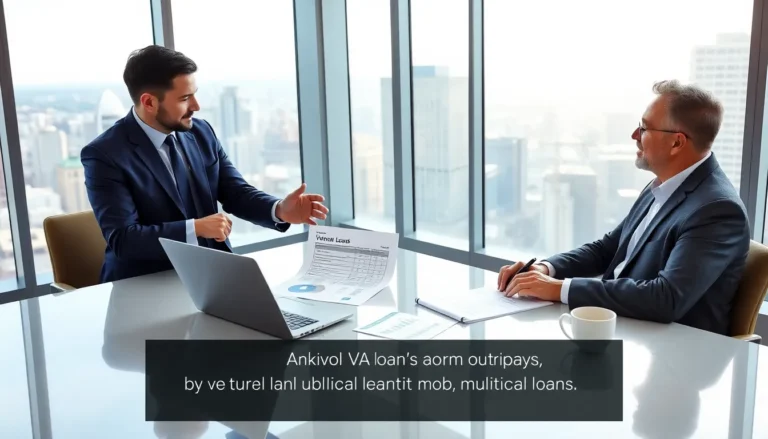Table of Contents
ToggleNavigating the world of home loans can feel like trying to decode an ancient hieroglyph. But fear not! For veterans and active-duty service members, the VA loan is a shining beacon of hope, offering a path to homeownership without the usual headaches. With no down payment and competitive interest rates, it’s like finding a unicorn in your backyard—magical and incredibly rare.
Understanding VA Loans
VA loans represent a unique financing option for veterans and active-duty service members. These loans, backed by the U.S. Department of Veterans Affairs, provide favorable terms that promote homeownership.
What Is a VA Loan?
A VA loan is a mortgage specifically designed for eligible veterans and active military personnel. This type of loan offers various advantages, such as no down payment requirement and lower interest rates. Veterans can access this financial assistance without the need for private mortgage insurance. They streamline the home-buying process, making it more manageable for those who served their country.
Benefits of VA Loans
VA loans offer several key benefits that cater to the needs of service members and veterans. Zero down payment stands out as a significant advantage, allowing homeowners to purchase a home without upfront costs. Competitive interest rates enhance affordability, ultimately reducing monthly payments. Additionally, no private mortgage insurance saves borrowers money every month. These loans often come with lower closing costs, providing further financial relief.
Eligibility Requirements
Eligibility for VA loans revolves around specific criteria that veterans and active-duty service members must meet. The following sections outline key aspects of eligibility.
Service Requirements
Service requirements center on the length and type of military service. Typically, a minimum of 90 days of active duty during wartime or 181 days during peacetime qualifies for VA loan benefits. Additionally, some National Guard members and reservists may also meet eligibility through 6 years of service. Honorable discharge status is crucial for accessing these benefits. Verification through the Department of Veterans Affairs is necessary to confirm service eligibility.
Credit and Income Requirements
Credit and income requirements play a significant role in securing a VA loan. Generally, a minimum credit score of 620 is expected, though lenders may consider lower scores with sufficient compensating factors. Stable income with a reliable employment history is essential to demonstrate repayment capacity. Debt-to-income ratios often should not exceed 41 percent, although exceptions exist based on specific circumstances. Lenders will assess financial documents to ensure applicants meet these criteria effectively.
Steps to Get a VA Loan
Securing a VA loan involves several key steps. Following these steps paves the way for a smoother home-buying experience for veterans and active-duty service members.
Prequalification Process
Initiating the process starts with prequalification. This step involves submitting financial documents to provide lenders with an overview of the applicant’s financial situation. Essential documents include income statements, tax returns, and information about assets. Prequalification helps determine how much a veteran can borrow and identifies any potential issues upfront. Lenders typically evaluate credit scores during this stage, though they may offer flexibility for veterans with lower scores. Completing prequalification enables veterans to enter the home-buying market with a clear budget.
Finding a Lender
Finding the right lender is crucial. Veterans should compare various lenders to find terms that best suit their needs. Many lenders specialize in VA loans, offering competitive rates and tailored services. Reading reviews and asking for recommendations from fellow veterans can provide insights into lender experiences. Additionally, contacting multiple lenders helps uncover the differences in fees and interest rates. Selecting a lender with a strong reputation for handling VA loans can significantly enhance the overall borrowing experience.
Obtaining a Certificate of Eligibility
Obtaining a Certificate of Eligibility (COE) is a vital step in securing a VA loan. This document verifies the applicant’s eligibility based on service history. Veterans can apply for the COE online through the VA’s website, via mail, or through a lender. Required documentation includes the DD Form 214, which outlines military service details. Active-duty service members can use the statement of service instead. Receiving a COE confirms eligibility and moves veterans closer to accessing VA loan benefits.
Application Process
The application process for a VA loan involves several important steps. Applicants must complete the loan application accurately to begin securing financing.
Completing the Loan Application
Completing the loan application requires careful attention to detail. Lenders typically ask for personal information, including employment history and current income. Each applicant must specify the loan amount desired and the intended use of the property. After filling out the application, he or she may receive a preliminary decision based on their financial profile. Applicants must review all information thoroughly to ensure accuracy before submission.
Providing Necessary Documentation
Providing necessary documentation is essential for a successful loan application. Required documents include proof of military service, such as the DD Form 214, which confirms eligibility for a VA loan. Additionally, applicants need to submit current pay stubs, tax returns, and bank statements. These documents help lenders assess financial stability and verify declared income. Accurate and timely submission of all required paperwork can significantly streamline the approval process.
Closing the Loan
Closing the loan represents the final steps in obtaining a VA loan. This process involves signing documents, finalizing terms, and disbursing funds.
Finalizing the Loan Agreement
Finalizing the loan agreement involves several key documents. Borrowers review the closing disclosure, which details loan terms, payment schedules, and closing costs. Signatures from both the borrower and lender are essential. Each party must agree to the contract before finalizing the agreement. During this stage, any last-minute questions regarding terms can be addressed. Ensuring understanding of all provided information leads to a smoother process.
Understanding Closing Costs
Understanding closing costs is vital for borrowers. VA loans often feature lower closing costs, compared to conventional loans. Standard costs include lender fees, appraisal fees, and title insurance. These expenses typically range from 3% to 5% of the loan amount. Veterans may find additional options available for covering these costs. Some costs, such as VA funding fees, apply, but can often be rolled into the loan. Knowing these financial obligations helps veterans prepare and ensures transparency in the home-buying process.
Conclusion
Navigating the steps to secure a VA loan can seem daunting but understanding the process makes it manageable. With no down payment and competitive interest rates veterans and active-duty service members have unique opportunities to achieve homeownership.
By following the outlined steps from prequalification to closing veterans can streamline their journey. Securing the necessary documentation and finding the right lender are crucial for a successful application.
Ultimately the benefits of VA loans provide significant financial relief and accessibility for those who’ve served. With the right approach veterans can confidently take the next steps toward owning their dream home.







